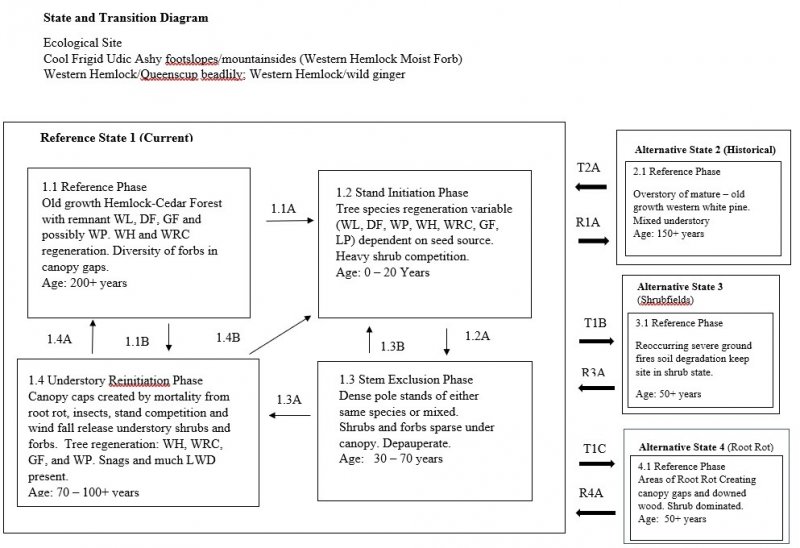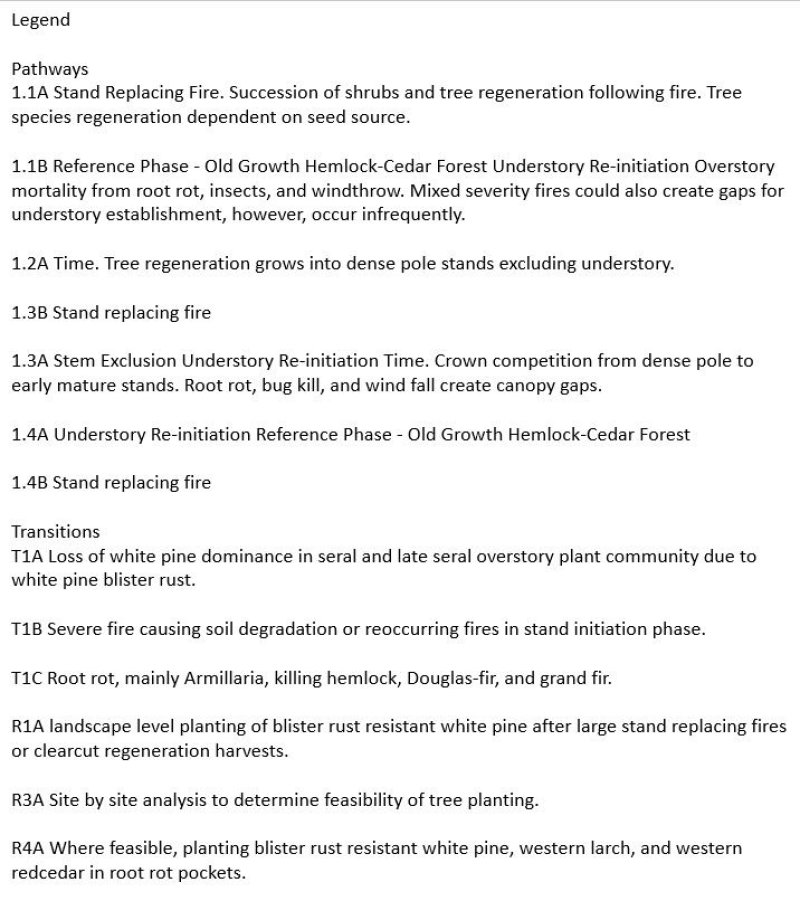
Natural Resources
Conservation Service
Ecological site F044AY504WA
Frigid, Udic, Loamy Foothills and Drainageways, high water table (Western Hemlock/Moist Forbes) Tsuga heterophylla / Clintonia uniflora , Tsuga heterophylla / Asarum caudatum
Last updated: 9/07/2023
Accessed: 12/19/2025
General information
Provisional. A provisional ecological site description has undergone quality control and quality assurance review. It contains a working state and transition model and enough information to identify the ecological site.
MLRA notes
Major Land Resource Area (MLRA): 044A–Northern Rocky Mountain Valleys
Major land resource area (MLRA): 044A-Northern Rocky Mountain Valleys
Description of MLRAs can be found in: United States Department of Agriculture, Natural Resources Conservation Service. 2006. Land Resource Regions and Major Land Resource Areas of the United States, the Caribbean, and the Pacific Basin. U.S. Department of Agriculture Handbook 296.
Available electronically at: http://www.nrcs.usda.gov/wps/portal/nrcs/detail/soils/ref/?cid=nrcs142p2_053624#handbook
LRU notes
Most commonly found in LRU 44A02 (Pend Oreille-Kootenai Valleys). Climate parameters were obtained from PRISM and other models for the area. Landscape descriptors are derived from USGS DEM products and their derivatives.
Classification relationships
Relationship to Other Established Classifications:
United States National Vegetation Classification (2008), A3612 Western Hemlock – Western Redcedar Cool-Mesic Central Rocky Mountain Forest & Woodland Alliance.
Washington Natural Heritage Program. Ecosystems of Washington State, A Guide to Identification, Rocchio and Crawford, 2015 - Northern Rocky Mt. Mesic Montane Mixed Conifer Forest (Cedar-Hemlock)
Description of Ecoregions of the United States, USFS PN # 1391, 1995 - M333 Northern Rocky Mt. Forest-Steppe-Coniferous Forest-Alpine Meadow Province
Level III and IV Ecoregions of WA, US EPA, June 2010 – 15y Selkirk Mountains, 15w Western Selkirk Maritime Forest.
This ecological site includes the following USDA Forest Service Plant Associations Western Hemlock Series: TSHE/CLUN, TSHE/ASCA. (Williams et. al. 1995)
Ecological site concept
This ecological site among the most productive in terms of forest production and biodiversity. Soils are loamy with volcanic ash mantling the surface, water tables are less than 30 inches deep, and have moderate to high available water holding capacity.
Associated sites
| F043AY519WA |
Warm-Frigid, Xeric, Loamy Slopes, low AWC subsoils (Douglas-Fir/Warm Dry Shrub) Pseudotsuga menziesii / Physocarpus malvaceus - Symphoricarpos albus Sites are on warm, dry aspects of hills and mountains. They are usually less about 30 inches deep with abundant rock fragments in the profile. Surfaces have some weak volcanic ash influence. Overstory species include Pseudotsuga menziesii var. glauca, and Pinus ponderosa. The understory is typified by Physocarpus malvaceus, Symphoricarpos albus, Calamagrostis rubescens, and Bromus vulgaris. |
|---|---|
| R043AY511ID |
Frigid Aquic Organic Depressions and Seeps (CAREX/SPHAG) Found on floodplains and seeps at cooler higher elevation locations. Confined to depressions and other areas of water accumulation. Have mucky surface textures. Found where MLRA 44A transitions to MLRA 43A in upper reaches of valleys. Site vegetation is dominated by a mix of wetland adapted species including Salix, Carex, and Sphagnum |
| F043AY521WA |
Warm-Frigid, Moist- Xeric Loamy Foothills/Mountainsides, ashy surface (Grand Fir Warm Dry Shrub) Abies grandis - Pseudotsuga menziesii / Physocarpus malvaceus - Symphoricarpos albus Found on lower Hill slopes, mountain slopes and terraces. Textures are loamy and sites lack a high water table. The soil surface has a distinct layer of volcanic ash material. Overstory species include Abies grandis and Pseudotsuga menziesii var. glauca. The understory is typified by Physocarpus malvaceus, Symphoricarpos albus, Calamagrostis rubescens, and Hieracium albiflorum. |
Similar sites
| F044AY505WA |
Frigid, Udic, Sandy Hill slopes and Outwash terraces (Western Hemlock/Moist Forbes) Tsuga heterophylla / Clintonia uniflora , Tsuga heterophylla / Asarum caudatum Found on sheltered sites with sandy parent material. Associated with sandy alluvial fans in Pend Oreille River Valley. While sites lack a high water table, reduced evapotranspiration helps promote more moisture demanding plant community. Overstory species include Tsuga heterophylla, and Thuja plicata. The understory is typified by subshrubs and forbs including Coptis occidentalis, Linnaea borealis ssp. Longiflora, Clintonia uniflora and Goodyera oblongifolia. |
|---|---|
| F043AY525WA |
Frigid, Udic, Loamy Foothills/Mountainsides, mixed ash surface (Western Hemlock/Moist Forbes) Tsuga heterophylla / Clintonia uniflora , Tsuga heterophylla / Asarum caudatum Found on higher, steeper hill and mountain slopes included in MLRA 43A. Sites lack high water table during spring. Overstory species include Tsuga heterophylla, and Thuja plicata. The understory is typified by subshrubs and forbs including Coptis occidentalis, Linna |
Table 1. Dominant plant species
| Tree |
(1) Tsuga heterophylla |
|---|---|
| Shrub |
(1) Coptis occidentalis |
| Herbaceous |
(1) Clintonia uniflora |
Click on box and path labels to scroll to the respective text.

